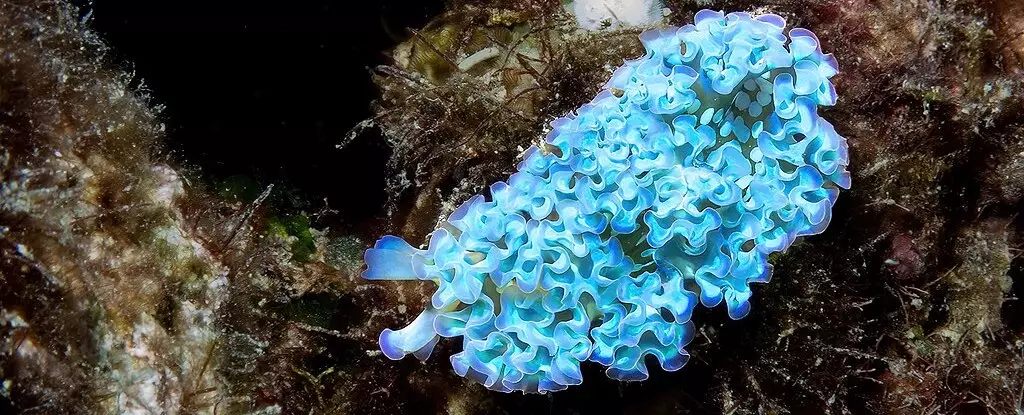The lettuce sea slug, known scientifically as *Elysia crispata*, presents a vivid image of nature’s most bizarre yet awe-inspiring ingenuity. At first glance, this creature might appear as a peculiar garnish in what could be described as an alien salad, adorned with vibrant hues of green and orange. However, its real-life capabilities are anything but mundane; this remarkable slug engages in a form of biological thievery that seems ripped from the pages of science fiction. It does not just consume algae; it obliterates the boundaries of individuality among organisms by stealing parts of the algae’s cells and repurposing them for its own energy needs.
What makes the lettuce sea slug so fascinating is not merely its unusual nutrient acquisition strategy but the efficiency with which it does so. Unlike most organisms that rely on traditional digestive processes to break down food and extract energy, this slug employs a far more sophisticated method. By commandeering algae’s photosynthesizing organelles known as chloroplasts, it essentially transforms itself into a living solar panel. This phenomenon raises essential questions about the dynamics of survival in the natural world, particularly regarding competition and innovation among species.
The Mechanics of Kleptoplasty
The real revelations about the lettuce sea slug’s biology have recently emerged from a groundbreaking study conducted by researchers at Harvard University. For years, scientists were aware of the slug’s extraordinary ability to appropriate the powers of other living organisms, but the exact mechanisms behind this kleptoplastic phenomenon remained elusive. The Harvard team has finally peeled back the layers of this biological enigma, revealing how *Elysia crispata* has honed the art of bio-piracy to a fine science.
Instead of merely digesting the chloroplasts, the slug ingeniously stores them in specialized structures known as ‘kleptosomes.’ These tiny sacs provide a nurturing environment that keeps the chloroplasts alive and functional. The chloroplasts, now ensconced within the slug’s cells, further integrate with the slug’s own proteins, a clear testament to the complexity and adaptability of life. One can easily imagine the microscopic drama playing out inside the slug as it combines the machinery of one organism with its own, resulting in an extraordinary partnership that defies simple explanations.
Harmonizing with its surroundings, the slug performs the ultimate trick of biological survival. Sunlight becomes its primary fuel source, allowing it to thrive in environments where food might be scarce. This raises significant ecological and evolutionary implications, compelling us to rethink the nature of symbiosis and resourcefulness. Here, nature’s ingenuity is fully on display as this creature stands as a testament to the potential for interchange and mutual benefit in the wild.
The Color of Survival
The color metamorphosis displayed by lettuce sea slugs further illuminates their extraordinary adaptability. When well-fed, they exhibit a vibrant green hue—indicating the abundance of chloroplasts at their disposal. Conversely, in times of scarcity, their coloration shifts to a muted orange, revealing the underlying struggle for sustenance. This adaptability does not merely signal a lack of food; it underscores a profound biological intelligence at play, enabling the slug to utilize its chloroplasts as both energy providers and camouflage.
Researchers suggest that these adaptations may indicate a more complex relationship with the chloroplasts than initially believed. The chloroplasts may serve multiple roles—beyond energy production, they could also act as food reserves, assist in avoiding predation, or even play a part in the slug’s reproductive strategies. This multifaceted functionality complicates our understanding of evolutionary biology and environmental responsiveness, inviting further exploration into the potential benefits of cellular cooperation.
In a world often characterized by ruthless competition, the lettuce sea slug highlights cooperation’s viability within nature. Its ability to share and incorporate traits from other organisms poses intriguing questions surrounding identity and survival in the wild. This slug illustrates how life’s intricacies can lead to profound synergies, urging us to look beyond the surface of predation and competition.
The world is far more interconnected than we often acknowledge, and the lettuce sea slug’s audacious life strategy exemplifies this fundamental truth. By delving deep into the mechanics of kleptoplasty, scientists are ushering in a new era of understanding regarding the complexities of life—an era that celebrates the tapestry of interactions that define our biological world. This tiny creature, seemingly unassuming, could unlock secrets that might change our fundamental grasp of evolution and interspecies relationships, challenging our perceptions about the lines that divide organisms in the grand narrative of life.

Leave a Reply